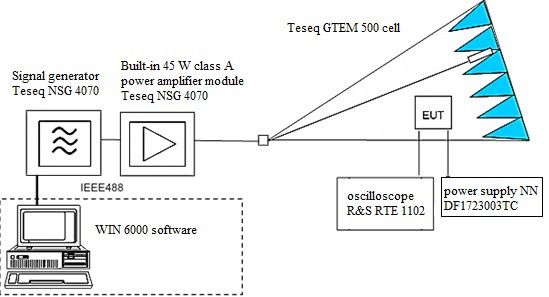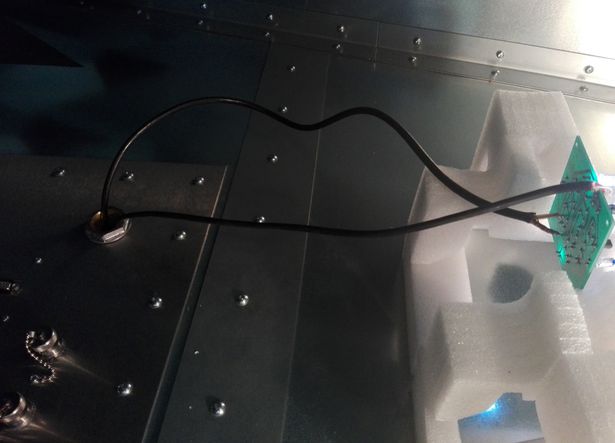Description
The dataset presents a result of measurements that are a part of electromagnetic field immunity tests. The radiated, radio frequency, immunity tests were carried out for a typical astable electronic multivibrator supplied from a power supply with an output voltage of 6V and 7.5 V. Tests of immunity of electronic systems to radiated radio frequency (RF) disturbances were performed with measurement set up under the requirements specified in the electromagnetic compatibility (EMC) standards.
In laboratory conditions, the electromagnetic fields were simulated in the GTEM (Gigahertz Transverse Electromagnetic) cell (Fig. 1). An integrated signal generator, equipped with a built-in 45 W class A power amplifier module, was used in the measurement setup. The tested multivibrator was supplied externally from the NDN DF1723003TC power supply for the output voltage of 6V and 7.5 V. The signal cable connected to the input of an oscilloscope was led out of the tested PCB. The measurement process was controlled by the WIN 6000 software installed on a personal computer connected to the signal generator via the IEEE488 interface.
A typical astable multivibrator was equipment under test (EUT) in the immunity measurements. The proper operation of the device is indicated by flashing LEDs with variable frequency. The system sensitivity to the radiated field in the GTEM cell was assessed based on the observation of the differences in the shape between the signal waveform controlling diode switching and the reference waveform recorded with the signal generator turned off.
The measurements were executed at a normative field strength of 10 V/m. The RF signal was modulated with a sinusoidal signal with a frequency of 1 kHz and a modulation depth of 80%.
For output voltage of the power supply equal to 6 V, the test procedure was carried out in the frequency range starting at 80 MHz and incrementing in 10% steps up to at least 1 GHz. Next, the frequency range was narrowed down to 100-300 MHz and the frequency step was reduced to 1%. The position of the equipment under test in the uniform area of the GTEM cell was changed for three orthogonal orientations x, y, z.

Figure 1. Configuration of the measuring system for testing the immunity of electronic systems
in the GTEM cell
For the output voltage of the power supply equal to 7.5 V, the measurement was performed only in the vertical position of the EUT (axis y) (Fig. 2). First, the test procedure was carried out in the frequency range starting at 80 MHz and incrementing in 10% steps up to at least 1 GHz. Then, the upper frequency was lowered to 300 MHz and the frequency step was reduced to 1%.
The attached files contain oscillograms showing the voltage waveforms recorded from the PCB. For each case, information about the RF frequency of the signal generator is included in the file description.


Dataset file
hexmd5(md5(part1)+md5(part2)+...)-{parts_count} where a single part of the file is 512 MB in size.Example script for calculation:
https://github.com/antespi/s3md5
File details
- License:
-
open in new tab
CC BYAttribution
Details
- Year of publication:
- 2021
- Verification date:
- 2021-06-28
- Creation date:
- 2016
- Dataset language:
- English
- Fields of science:
-
- Automation, electronic and electrical engineering (Engineering and Technology)
- DOI:
- DOI ID 10.34808/cxrm-hr74 open in new tab
- Series:
- Verified by:
- Gdańsk University of Technology
Keywords
- electromagnetic field
- immunity test
- astable electronic multivibrator
- GTEM cell
- EMC
- radio frequency disturbances
References
- dataset The standard radiated immunity test of an astable multivibrator at a normative field strength
Cite as
Authors
seen 135 times

